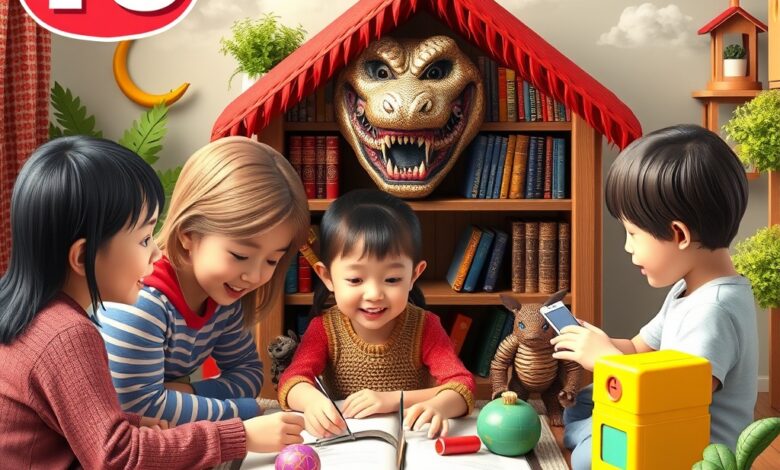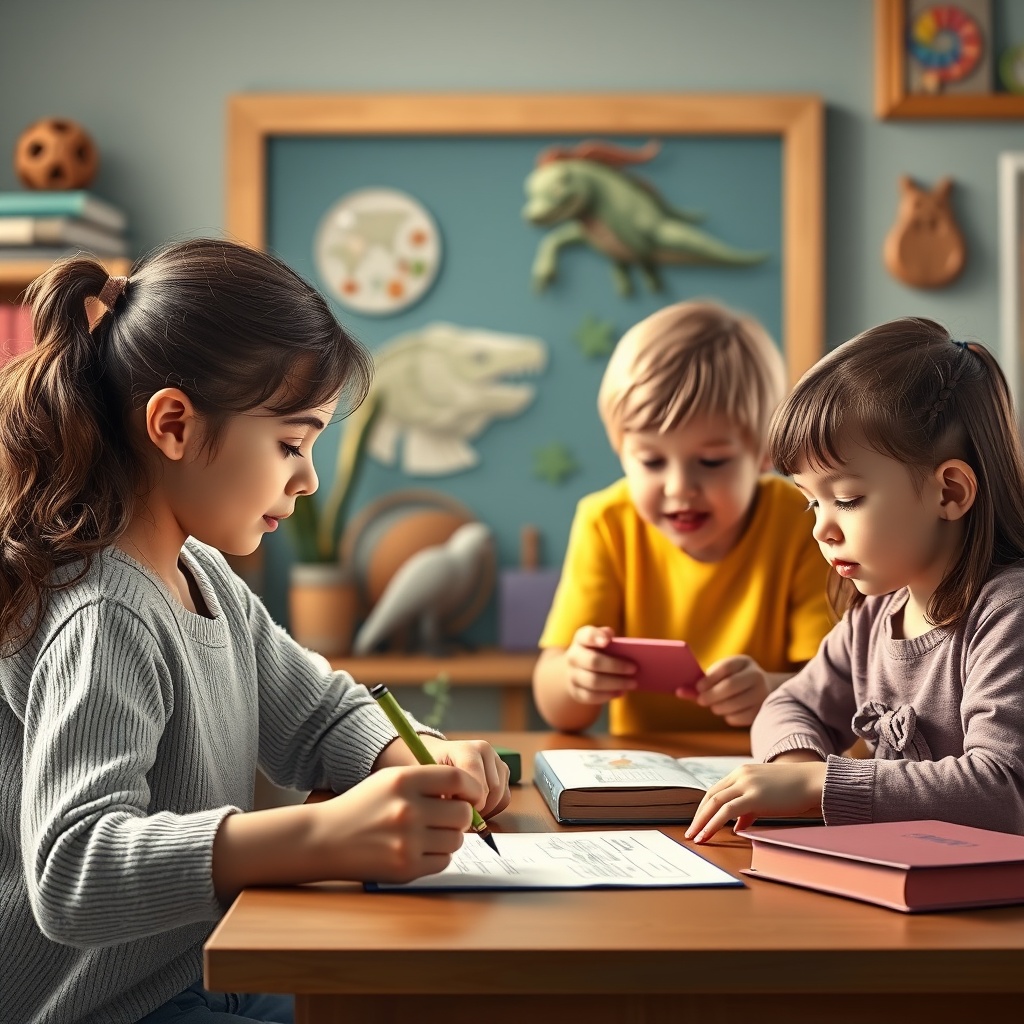10 Engaging Family Educational Activities to Boost Learning at Home

In today’s fast-paced world, finding ways to engage your family in learning can be a challenge. However, incorporating educational activities at home not only enhances knowledge but also strengthens bonds. Imagine turning an ordinary afternoon into an exciting adventure of discovery and creativity! Whether it’s through games, crafts, or virtual experiences, there are endless possibilities to make learning fun for everyone.
Dive into this blog post to explore ten engaging family educational activities that will spark curiosity and inspire growth right in your own living room or backyard. Let’s embark on this journey together!
The Importance of Family Educational Activities
Family educational activities play a crucial role in fostering learning. They transform the home into an interactive classroom, where curiosity thrives.

Engaging together creates a supportive environment. Family members can share knowledge and skills with one another, making lessons more relatable and enjoyable. This collaboration encourages open communication and builds confidence.
Moreover, these activities strengthen family bonds. Working on projects or playing games cultivates teamwork and shared experiences that last a lifetime. It’s about creating memories while nurturing intellectual growth.
Involving everyone in the learning process also helps develop critical thinking skills. Different perspectives lead to deeper understanding of concepts and ideas.
Integrating education naturally into daily life makes it less intimidating for children. Learning becomes part of their routine rather than a chore, igniting lifelong passions for discovery outside traditional settings.
Indoor Activities
Indoor activities can transform a typical day into an engaging learning experience. Board games are a fantastic way to combine fun and education. They teach strategy, critical thinking, and teamwork while bringing the family closer together.
Arts and crafts offer a creative outlet for children of all ages. From painting to scrapbooking, these projects spark imagination and enhance fine motor skills. It’s also an opportunity for parents to bond with their kids over shared creativity.
Cooking and baking together is more than just making meals; it’s a delicious educational adventure. Measuring ingredients teaches math concepts, while following recipes improves reading comprehension. Plus, everyone gets to enjoy tasty treats at the end!
These indoor activities not only boost cognitive development but also create cherished family memories that last long after the activity ends.
A. Board Games
Board games are a fantastic way to foster learning while having fun as a family. They encourage strategic thinking, problem-solving, and communication skills.
Choose games that align with your children’s ages and interests. Classics like Monopoly teach math and money management, while Scrabble enhances vocabulary.
Setting up game night can be an exciting ritual. Gather snacks, create a cozy atmosphere, and let the competition begin! The laughter shared during gameplay strengthens bonds.
Don’t forget about cooperative board games where everyone works together toward a common goal. These promote teamwork and social interaction.
As you play, ask open-ended questions to deepen understanding of the rules or strategies involved. This encourages kids to think critically about their choices.
Incorporating educational themes into your selection adds another layer of learning without it feeling forced.
B. Arts and Crafts
Arts and crafts offer a wonderful opportunity for families to get creative together. Gather supplies like paper, paints, markers, and recyclables. Let your imaginations run wild.
You could create seasonal decorations or personalized gifts for friends and family. Making cards or scrapbooks can be especially meaningful. Each piece tells a story.
Consider setting up themed craft days—like “Nature Art” where you use leaves, flowers, and twigs collected during outdoor adventures. This not only connects art with nature but also sparks discussions about the environment.
Don’t forget to celebrate each creation! Display them proudly in your home or share pictures on social media. The experience fosters bonding and makes learning fun without the pressure of traditional education methods.
Explore different techniques too; try painting with watercolors one day and sculpting clay the next. There’s no limit to what you can create when everyone contributes their unique ideas.
C. Cooking and Baking Together
Cooking and baking together can be a delightful experience for families. It’s not just about making meals; it’s an opportunity to bond while learning valuable skills.
Kids can practice math by measuring ingredients or learn science through the reactions of baking soda and vinegar. Each recipe becomes a mini-lesson in both nutrition and creativity.
Involving children in meal preparation fosters independence as they gain confidence in the kitchen. They’ll feel proud when they serve dishes they’ve helped create.
Experimenting with recipes allows for discussions about different cultures, flavors, and food origins. This broadens their understanding of the world around them.
Don’t forget to have fun! Singing along to music or sharing stories during prep time adds laughter into the mix, making memories that will last long after the cookies are gone.
Outdoor Activities
Getting outside can spark curiosity and creativity in children. Nature walks provide a perfect opportunity for families to explore local parks or trails. As you walk, talk about the different plants and animals you encounter. This not only enhances observation skills but also fosters an appreciation for nature.
Scavenger hunts amplify this experience by adding excitement. Create a list of items to find—like specific leaves, rocks, or insects—and encourage teamwork as everyone searches together.
Gardening is another fantastic outdoor activity that combines learning with hands-on fun. Whether planting flowers or vegetables, kids learn about responsibility while nurturing their green thumbs. They’ll watch their efforts blossom over time.
These activities enhance physical health and strengthen family bonds through shared experiences in the great outdoors.
A. Nature Walks and Scavenger Hunts
Nature walks are a fantastic way to blend education with the great outdoors. Grab your family and explore local parks or nature reserves. Each step opens up new learning opportunities.
Turn your walk into a scavenger hunt. Create a list of items like specific leaves, rocks, or flowers for everyone to find. This not only keeps kids engaged but also teaches them about biodiversity.
Encourage children to observe their surroundings closely. Discuss different plants and animals encountered along the way. Ask questions that spark curiosity—what color is that bird? Why do certain trees grow in clusters?
Incorporating storytelling can enhance the experience too. Share folklore related to local flora and fauna as you wander through trails together.
These activities foster teamwork while promoting physical health, making every outing both educational and memorable for the whole family.
B. Gardening and Planting
Gardening and planting is a fantastic way to combine fun with learning. It engages kids in nature while teaching them about biology, ecology, and responsibility.
Start by selecting seeds or young plants together. Discuss what each plant needs to thrive, like sunlight and water. This hands-on experience fosters curiosity about how living things grow.
As you dig in the soil, explore concepts such as photosynthesis or the importance of bees in pollination. Every visit to your garden can become an adventure filled with discovery.
Watching plants sprout is rewarding for everyone involved. Children gain patience as they wait for their efforts to bear fruit—literally!
Gardening also promotes teamwork and communication. Assign different tasks based on interests or strengths; one might love watering while another enjoys weeding.
Virtual Learning Activities
Virtual learning activities can be a fantastic way to engage the family in education. With technology at our fingertips, exploration has never been easier.
One popular option is virtual field trips. These online tours allow families to explore museums, national parks, and historical sites worldwide without leaving home. It’s an adventure right from your living room!
Online educational games are another thrilling option. Many websites offer interactive games that teach math, science, and languages while keeping children entertained. Competitions among family members can enhance the fun.
Combining these activities with discussions afterward helps reinforce what everyone learned during the experience. Sharing thoughts encourages critical thinking and deeper understanding.
With so many resources available online, virtual learning turns into a dynamic addition to any family’s educational journey!
A. Virtual Field Trips
Virtual field trips offer a fantastic way for families to explore the world without leaving home. With just a few clicks, you can visit museums, national parks, and historical landmarks from your living room.
Many institutions now provide guided tours through their websites. You can wander through art galleries in Paris or dive into ocean habitats with marine biologists. This immersive experience sparks curiosity and expands knowledge.
To make it even more engaging, encourage discussions after each trip. Ask questions about what everyone learned or found interesting. It promotes critical thinking and deepens understanding.
Combine virtual trips with themed activities at home for added fun. If you “visit” Ancient Egypt, try creating pyramids using household items afterward. The possibilities are endless when education meets exploration right at your fingertips!
B. Online Educational Games
Online educational games are an exciting way to blend fun with learning. They offer a vast array of subjects, from math and science to language arts and history. Engaging graphics and interactive elements keep kids captivated.
Many platforms cater to different age groups, ensuring that everyone finds something suitable. These games can be played solo or in multiplayer modes, promoting both independent thinking and collaborative skills.
Parents can track progress on many sites, making it easier to celebrate achievements or identify areas for improvement. This feedback loop encourages kids to stay motivated.
Games often incorporate storytelling aspects that enhance creativity while reinforcing educational concepts. Players embark on adventures where they solve puzzles or complete challenges tied directly to the subject matter.
With countless options available online, finding the right game becomes a delightful journey itself—turning screen time into valuable learning experiences for the entire family.
Collaborative Projects
Collaborative projects can be a fantastic way to engage the whole family. They encourage teamwork and spark creativity, making learning feel like an adventure.
Consider creating a family scrapbook. Each member can contribute stories, photos, or drawings that reflect your experiences together. This not only fosters communication but also builds lasting memories.
Another idea is to work on a community service project as a family. Whether it’s organizing a neighborhood clean-up or volunteering at a local shelter, these activities teach valuable lessons about empathy and responsibility.
You might also explore science experiments where everyone has specific roles. From measuring ingredients to documenting results, each person plays an integral part in the process.
You could embark on building something together—like furniture or even model kits. Collaborating on tangible outcomes enhances problem-solving skills while reinforcing the importance of working together toward common goals.
Incorporating Education into Everyday Tasks
Transforming everyday tasks into learning experiences can be both fun and practical. While cooking dinner, involve the kids in measuring ingredients. This not only teaches them about math but also enhances their comprehension of fractions.
Grocery shopping presents another opportunity for education. Ask your children to create a shopping list based on a week’s meals. They’ll practice writing skills while also learning about budgeting and nutrition.
Household chores can be turned into science lessons too. Discuss why we clean certain areas or the importance of recycling as you tackle tidying up together.
Even during car rides, engage in discussions that challenge critical thinking. Play games like “20 Questions” or have debates on various topics to enhance verbal skills.
Integrating these activities encourages an ongoing dialogue about learning without making it feel forced or tedious.
Setting Goals
Setting goals plays a vital role in making family educational activities effective. It helps create focus and direction for everyone involved. By establishing clear, achievable objectives, families can track their progress and celebrate successes together.
Start by identifying specific areas where you want to see improvement or growth. This could be enhancing math skills through board games or fostering creativity with arts and crafts projects. Once you’ve set your goals, break them down into smaller milestones that are manageable.
Encourage each family member to share their personal learning objectives as well. This not only promotes accountability but also fosters an environment of support and collaboration within the family unit.
Regularly revisiting these goals keeps everyone engaged and motivated. Celebrate achievements along the way, no matter how small they may seem! Remember, the key is to make learning enjoyable while nurturing curiosity at home.
By incorporating goal-setting into your family’s routine, you’ll build a foundation of lifelong learners ready to tackle new challenges together.



